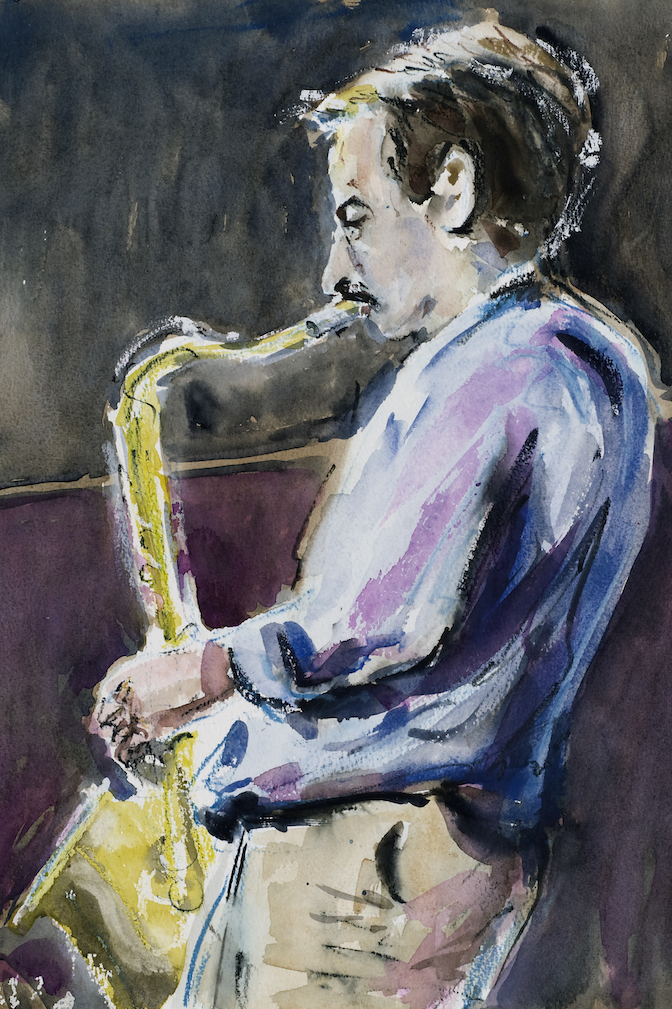The concert was the prelude to the first Jazz Study Weekend to be held at Christ’s Hospital, that famous school near Horsham. All praise to the Artistic Director who, during the last couple of years, has dipped his toe into the uncertain waters of jazz promotion, with concerts by Chris McGregor, Graham Collier and Stan Tracey. Bobby Wellins is not a well-known name, even to the jazz public. This ignorance is unforgiveable; his present quartet must be one of the most creative, exciting and satisfying units in Britain today.
His tone is unique, his playing so full of contrasts: beautiful and fierce; haunting and muscular; introverted and earthy. His improvisations are endlessly imaginative
Wellins, dapper and relaxed, announced the first number from his “Culloden Moor” suite. A dramatic start – martial drum and cymbal rolls; one repeated note on the piano; a bass figure; the theme, and then the development. Next “Melancholy Baby” with Wellins’ tenor nursing and nudging the melody, skilfully and affectionately dislocating the time. Pianist Peter Jacobson suddenly grabbed the tune by the scruff of the neck, accelerated the time, solo’d and then gradually returned to the initial tempo. “In a Sentimental Mood” gave us a further insight into the improviser’s skill in exploring, examining and elucidating those lovely changes. The aptly named “Ba-lues” displayed another facet of the Wellins art — the slow solo line over a fast, turbulent background.
The concert displayed the quartet as a team rather than just a trio with soloist, although it naturally centres on Wellins. His tone is unique, his playing so full of contrasts: beautiful and fierce; haunting and muscular; introverted and earthy. His improvisations are endlessly imaginative. Listen to him building a typical solo: conjuring a phrase, repeating it, adding to it, stretching out and then reducing it to the original, all achieved with rhythmic and harmonic facility.
Spike Wells on drums, at times, produces a multi-layered gale of sound over which Wellins floats with apparent unconcern. At other times he will be free, leaning into his kit, head cocked to one side, interpreting the moment with brushed cymbal or crackling snare, changing the mood and direction of a piece, picking up and throwing out new patterns and themes, but never losing the pulse. His understanding with Peter Jacobson is uncanny. He is a classically trained pianist and arrived via Major Surgery and the simpler funky music scene. He appears impassive, his blindness shielded by dark glasses, but his playing is ebullient and irrepressible.
Underpinning and binding together this interplay is the strong and accurate playing of bassist Adrian Kendon. He is the link between the various parts of a performance, not allowing the tension to die completely but pointing the way to the next stage.
The Study Weekend which followed was designed to give jazz musicians an opportunity to work with Bobby Wellins. The aim was to encourage their skills by developing their insight into various aspects of the jazz musician’s art. Sessions were planned under the headings rhythm, harmony, melody and imagination. An ambitious project. Spectators were also invited.
Trane’s Impressions: many were appalled at being faced with so much space. Deprived of their comfortable licks against familiar changes, some gave up and resorted to a verbal condemnation of modern jazz and all they thought it represented
The response was good and attracted young rock-style guitarists as well as more senior gents who were sick to death of playing the same tired old phrases. In fact the number of young people present was encouraging for here were the performers and audiences of tomorrow. Adrian Kendon’s assistance was invaluable, and his theoretical knowledge and timely chairmanship contributed much to the success of the workshop. Well-known standards were used to illustrate the themes. The last, and undoubtedly the toughest session was on imagination in jazz. John Coltrane’s “Impressions”was used as the working example. This is a 32 bar structure, based on the Dorian scale, the first 16 bars in D minor, the next 8 bars up a semi-tone and then back to D Minor in the final eight. This simple formula produced all manner of problems. It was not until after much furious bar counting had elapsed that the shape of the piece could be felt and even then the change was hesitant at times and this threw everything out of gear. Many were appalled at being faced with so much space. Deprived of their comfortable licks against familiar changes, some gave up and resorted to a verbal condemnation of modern jazz and all they thought it represented. The young folk, who were coping quite well with this section, were amazed and amused at these heated prejudices. Peace was finally restored, but the lessons had struck home.
Jazz is a formidable art. Musicians had been reminded that, although many can make jazz to some standard sometimes, constant application to theory and instrument are essential ingredients for greater expression and satisfaction.
The spectators had been afforded the pleasure of watching Bobby Wellins at work and although audiences in this part of the world will continue to be desperately small, on some occasions at least they will be a little more knowledgeable.
Eric Starr
















